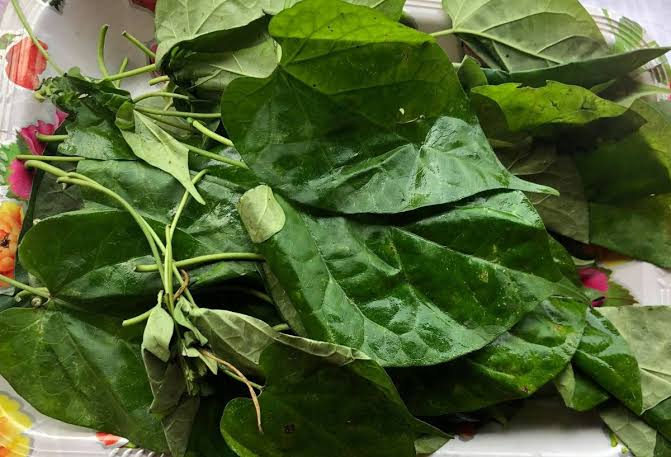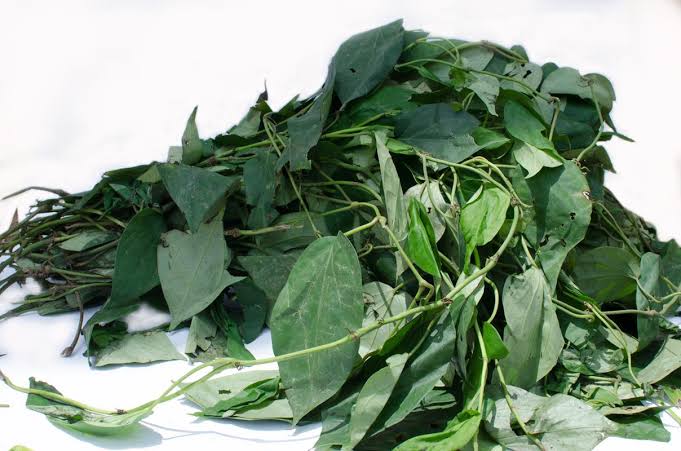Utazi leaf, known scientifically as Gongronema latifolium, is a popular plant in West Africa, especially in Nigeria. Recognized for its unique, slightly bitter taste and impressive health benefits, it has been widely used in traditional dishes and natural medicine.
The leaves of this perennial plant are often added to soups, stews, and herbal remedies, not only for flavor but also because of their medicinal qualities. Utazi has earned a reputation as a valuable plant for managing various health conditions and promoting overall well-being.
In traditional Nigerian medicine, utazi is cherished for its role in addressing issues like digestive problems, infections, and even malaria. It’s common to find utazi included in herbal teas or drinks made for easing inflammation or fighting infections.
The effectiveness of utazi in these areas comes from the high levels of specific nutrients and beneficial compounds within the leaf, which help support the body’s health and healing processes. Over time, as people continue to explore natural ways to maintain health, the popularity of utazi has only grown.
Nutritionally, utazi leaf contains essential vitamins and minerals that help boost the immune system, protect cells, and support vital bodily functions. It’s particularly rich in vitamins A and C, both of which are powerful antioxidants.
Vitamin A is essential for eye health, skin health, and a strong immune system, while vitamin C is widely known for its role in defending against infections and promoting skin health. These vitamins are a big reason why utazi is valued as a health-boosting addition to the diet.
The leaf also contains valuable minerals like potassium, calcium, and magnesium. Potassium is necessary for maintaining healthy blood pressure and supporting the function of the heart and muscles.
Calcium and magnesium, on the other hand, are essential for strong bones, muscle function, and nerve health. Because of these nutrients, utazi can be especially beneficial for people looking to support their health naturally, adding vital elements that may be missing in a diet that lacks enough fresh, whole foods.
One of the remarkable aspects of utazi leaf lies in its chemical makeup. It contains several bioactive compounds—such as flavonoids, alkaloids, tannins, and saponins—which contribute to its healing qualities. Flavonoids, for example, are antioxidants that help the body protect itself from cellular damage and reduce inflammation.
This property makes flavonoids useful for preventing conditions like heart disease and other inflammatory-related health issues. The presence of alkaloids adds another layer of benefit, as they are known to have stimulating effects on the central nervous system, potentially improving mental alertness.
Saponins are another beneficial component found in utazi leaf. These compounds help lower cholesterol levels and boost the immune system by activating immune cells that fight infections. This is partly why utazi is sometimes used as a remedy for respiratory infections or fevers.
Tannins, which also appear in the leaf, have astringent qualities that can help reduce inflammation, especially in the digestive tract. This makes utazi a supportive natural remedy for digestion-related issues and contributes to overall gut health.
Scientific research is gradually confirming the traditional uses of utazi leaf, showing that its powerful antioxidants can play a role in lowering inflammation, a significant factor in conditions like arthritis and digestive problems.
By consuming utazi regularly, people may find a natural way to support processes that can be affected by stress, poor diet, or aging. Utazi’s distinctive bitterness is more than a taste factor; it has health benefits as well.
Bitter compounds are known to stimulate the release of digestive enzymes, which can aid digestion and improve nutrient absorption. Additionally, utazi has shown potential in supporting blood sugar control and combating malaria.
Studies suggest that its anti-malarial and blood sugar-lowering effects might come from the unique combination of compounds like alkaloids and flavonoids, which work together to regulate metabolism and reduce blood sugar levels. Utazi also has antimicrobial properties, meaning it can help fight off harmful bacteria.
This benefit makes it a useful remedy in communities where access to conventional medicine might be limited. Its ability to help cleanse the body of harmful microbes and strengthen the immune system has contributed to its role in traditional medicine as a natural protector against illness.
In addition to its medicinal uses, utazi leaf is rich in dietary fiber, which benefits digestion and overall health. Fiber supports regular bowel movements and helps with weight management by creating a sense of fullness, aiding in better appetite control. This is especially helpful for people working to maintain a healthy weight or looking for natural ways to support a balanced diet.
Read Also: Roots and Tuber Crops: Types, Cultivation, and Uses
Health Benefits of Utazi Leaf

1. Rich in Antioxidants: One of the primary advantages of utazi leaf is its high antioxidant content. Antioxidants are crucial for protecting the body’s cells from free radicals, harmful molecules that can speed up aging and contribute to chronic diseases like heart disease and cancer.
By incorporating utazi leaf into the diet, you supply the body with powerful antioxidants that help reduce oxidative stress, keep cells healthy, and lower the risk of various long-term illnesses.
2. Boosts Immune System: Utazi leaf is rich in immune-boosting vitamins and minerals, particularly vitamin C and zinc. Vitamin C strengthens the immune system by helping the body fight infections, while zinc is essential for wound healing and immune support. Together, these nutrients make the leaf an effective choice for enhancing the immune system and supporting overall health, making it easier to fend off common infections.
3. Anti-Inflammatory Properties: The bioactive compounds in this leaf, include flavonoids and saponins, contribute to its powerful anti-inflammatory effects. Chronic inflammation is a root cause of various health conditions, such as arthritis, diabetes, and cardiovascular disease.
Consuming utazi leaf regularly can help reduce inflammation, ease joint pain, and lower the risk of inflammation-related diseases. For those dealing with inflammatory health issues, utazi leaf offers a natural way to manage discomfort and promote relief.
4. Supports Heart Health: Utazi leaf is beneficial for heart health due to its high levels of potassium, antioxidants, and certain bioactive compounds that help regulate blood pressure and cholesterol. Potassium supports healthy blood pressure, and antioxidants prevent oxidative stress that can damage blood vessels.
Additionally, it may help to lower bad cholesterol (LDL) and increase good cholesterol (HDL), helping reduce the risk of heart-related issues, such as stroke and heart attack.
5. Helps Regulate Blood Sugar Levels: Known as a natural remedy for managing blood sugar levels, utazi leaf is particularly helpful for people with diabetes or those at risk of developing it.
Compounds in utazi leaf help enhance insulin sensitivity and regulate blood glucose levels, supporting balanced blood sugar. Including the leaf in one’s diet can assist in preventing blood sugar spikes, naturally complementing medical treatments for diabetes.
6. Aids in Digestion and Relieves Constipation: The natural bitterness of utazi leaf plays a role in aiding digestion by stimulating bile production, an essential component for breaking down fats. The leaf also acts as a mild laxative, which can help relieve constipation and support regular bowel movements. For those experiencing digestive issues, including bloating or indigestion, it can offer natural relief and improve digestive comfort.
7. Enhances Liver Function and Detoxification: Utazi is often used as a detoxifier to support liver health. Its bitter compounds stimulate bile production and help the liver remove toxins from the body more effectively.
By incorporating the leaf into the diet, you support liver function, cleanse the body, and promote a more efficient metabolism. This detoxifying quality makes utazi leaf particularly beneficial for individuals looking to cleanse naturally and maintain a healthy liver.
8. Relieves Respiratory Issues: In traditional medicine, utazi leaf has been used to help relieve respiratory issues, including coughs, colds, and bronchitis. Its antimicrobial and anti-inflammatory properties make it effective in soothing irritated respiratory passages, reducing mucus, and alleviating congestion. Drinking utazi leaf tea or using it in steam inhalation can help relieve symptoms of respiratory discomfort, making it especially helpful during flu seasons.
9. Supports Weight Management: The leaf is a helpful ally in weight management due to its ability to reduce appetite and minimize cravings for sugary and fatty foods. The fiber content in utazi leaf provides a feeling of fullness, helping prevent overeating.
Additionally, the plant’s digestive and detoxifying effects support a healthy metabolism, aiding those looking to maintain a healthy weight naturally as part of a balanced diet.
10. Benefits Skin Health: The antioxidant and anti-inflammatory properties of utazi leaf also benefit skin health by preventing cellular damage and slowing down visible signs of aging.
The leaf contains high levels of vitamin C, which promotes collagen production, an essential factor in firm, youthful skin. Regular use of the leaf, whether in food or as an herbal remedy, can keep the skin looking fresh, promote healing of minor wounds, and even help clear up acne.
11. Reduces Stress and Anxiety: Utazi leaf contains natural compounds with calming effects, making it useful for stress relief. In traditional practices, the leaf is often used as a mild relaxant, providing a gentle and natural way to cope with mental and emotional stress. Drinking utazi leaf tea or using it in aromatherapy may improve mood, promote relaxation, and reduce anxiety levels.
12. Boosts Energy Levels: Packed with essential nutrients, particularly iron and B vitamins, the leaf can also help to combat fatigue and boost energy. Iron supports oxygen transport in the blood, helping reduce tiredness, while B vitamins aid metabolism and energy production. For those who often feel fatigued or low on energy.
Read Also: Health Benefits of Sidaacuta Tea
Traditional Uses and Preparations of Utazi Leaf for Maximum Benefit

1. Medicinal Teas for Digestive Health and Immunity: One of the most common ways to prepare utazi leaf for its health benefits is as an herbal tea. This preparation method is popular in traditional medicine for its simplicity and effectiveness. When steeped in hot water, the leaf releases bioactive compounds that provide a host of benefits, particularly for digestion and immunity.
The bitterness of utazi leaf stimulates bile production, aiding the digestive process and helping the body break down fats more efficiently. As a result, utazi tea is often consumed after meals to prevent indigestion, bloating, or constipation.
The tea preparation is straightforward: a handful of fresh or dried utazi leaves are washed thoroughly, then boiled in water for 10–15 minutes. The tea is often allowed to steep further after boiling to release its full range of medicinal compounds. This drink can be consumed warm or cool, depending on preference.
In addition to aiding digestion, utazi tea is rich in antioxidants and vitamin C, which support immune health by protecting cells from damage and enhancing the body’s natural defenses.
2. Chewing Fresh Utazi Leaf for Blood Sugar Control: In traditional African herbal practices, chewing fresh utazi leaf is a method often used by people looking to regulate blood sugar levels. Chewing the leaves allows the body to absorb the bioactive compounds directly, which is thought to increase insulin sensitivity and support balanced blood glucose levels.
This practice is particularly useful for individuals with diabetes or pre-diabetes, as it helps to manage blood sugar spikes naturally. The bitter compounds in utazi leaf are believed to stimulate insulin production, making it easier for the body to process sugars efficiently.
Chewing fresh utazi leaf may not appeal to everyone due to its strong bitter taste, but for those who can handle the flavor, it is considered one of the most effective ways to benefit from the plant’s glucose-regulating properties. Some people follow the chewing practice as part of their daily routine, typically before meals, to aid in blood sugar regulation.
3. Utazi Leaf Infusions for Respiratory Health: Respiratory issues, including coughs, colds, and bronchitis, are traditionally treated with utazi leaf infusions. In this method, fresh utazi leaves are steeped in hot water, creating a strong infusion that can be used for drinking or inhaling as steam.
This infusion method is valued for its ability to clear respiratory passages and soothe irritation in the airways. The antimicrobial and anti-inflammatory properties of utazi leaf help alleviate congestion and reduce mucus buildup, making breathing easier.
To make an infusion for respiratory relief, fresh utazi leaves are boiled in water for about 15–20 minutes to release their medicinal compounds. Once boiled, the infusion can be consumed as a hot drink or used for steam inhalation.
For steam inhalation, the boiling pot is carefully positioned so that the steam can be inhaled, often with a towel over the head to trap the steam. This practice helps to clear the sinuses and relieve respiratory discomfort, especially during cold seasons.
4. Utazi Leaf Poultices for Inflammation and Skin Conditions: Another traditional preparation of utazi leaf is the poultice, used for external applications to treat inflammation, joint pain, and certain skin conditions.
A poultice is a soft, moist preparation made by crushing utazi leaves and mixing them with a small amount of water to form a paste. The paste is then applied to the affected area, covered with a cloth, and left in place for several hours.
The anti-inflammatory properties of the leaf make it effective for soothing joint pain and reducing inflammation. For individuals with arthritis or joint discomfort, using a utazi leaf poultice regularly can provide relief and reduce swelling.
The poultice can also be used to treat minor skin issues, such as rashes, insect bites, and mild infections. When applied to the skin, utazi leaf’s antimicrobial compounds help to cleanse the area and promote healing.
5. Adding Utazi Leaf to Traditional Dishes: Utazi leaf is commonly used in West African cooking, not only for its distinct taste but also for its health benefits. It is particularly popular in Nigerian cuisine, where it is added to soups, stews, and sauces. Incorporating the leaf into meals is a practical way to consume it regularly and gain its health benefits without the need for special preparations.
Traditional dishes such as pepper soup and vegetable soups often feature utazi leaf, either as a main ingredient or as a garnish, adding flavor and nutritional value. In pepper soup, for example, the leaf is added toward the end of cooking to preserve its flavor and nutritional integrity.
The bitterness of the leaf complements the spicy broth, creating a balanced taste that enhances the overall flavor. Including utazi leaf in meals can support digestion, as the bitter compounds stimulate the digestive system. Also, the antioxidants in the leaf help to protect cells from damage, supporting overall wellness through everyday consumption.
6. Herbal Concoctions and Detox Drinks: Utazi leaf is also a primary ingredient in traditional herbal concoctions and detox drinks, often paired with other medicinal plants. These detox drinks are made to cleanse the liver, support kidney function, and rid the body of toxins.
In such preparations, utazi leaves are combined with other local ingredients like ginger, garlic, and lime, creating a powerful herbal blend. To prepare a detox drink, a handful of fresh utazi leaves is washed, chopped, and combined with crushed ginger and garlic. The mixture is boiled in water for about 20 minutes, and then strained to remove the solids.
The resulting liquid can be consumed warm or cold, and it’s often taken first thing in the morning on an empty stomach to maximize its detoxifying effects. This drink helps cleanse the liver, improves digestion, and boosts energy levels, making it a staple in many traditional wellness practices.
7. Utazi Leaf as a Natural Remedy for Weight Management: In traditional practices, utazi leaf is also used as a natural appetite suppressant and a tool for weight management. The bitterness of the leaf reduces cravings for sweet and fatty foods, making it easier to manage portion sizes and avoid overeating.
Some individuals chew a small portion of the leaf before meals to help control appetite, while others drink utazi tea to stay full longer and reduce the likelihood of snacking between meals. The fiber in utazi leaf contributes to a feeling of fullness, helping people maintain a balanced diet. For those seeking to lose weight or maintain a healthy weight.
Frequently Asked Questions about the Health Benefits of Utazi Leaf

1. What is utazi leaf, and where is it commonly found?
Utazi leaf, scientifically known as Gongronema latifolium, is a bitter herb native to West Africa. It is widely found in countries like Nigeria, Ghana, and Cameroon, where it is used in traditional cooking and herbal medicine.
2. What are the main health benefits of utazi leaf?
Utazi leaf offers numerous health benefits, including boosting the immune system, supporting digestive health, managing blood sugar levels, and promoting heart health. It is also known for its anti-inflammatory and antioxidant properties, which help combat various health issues.
3. How can I prepare utazi leaf for health benefits?
Utazi leaf can be prepared in several ways, such as brewing it into a tea, chewing the fresh leaves, or using it in cooking. To make a tea, simply steep fresh or dried utazi leaves in hot water for 10–15 minutes. For fresh leaves, they can be chewed directly to harness their medicinal properties.
4. Can utazi leaf help with weight management?
Yes, utazi leaf can aid in weight management. Its bitter taste helps suppress appetite, making it easier to avoid overeating. Additionally, the fiber content in utazi leaves promotes a feeling of fullness, which can help individuals control their food intake.
5. Does utazi leaf have any benefits for skin health?
Utazi leaf possesses anti-inflammatory and antioxidant properties, which can be beneficial for skin health. Applying a poultice made from crushed utazi leaves can help soothe minor skin irritations, rashes, and insect bites. Its antimicrobial effects also promote healing.
6. Can utazi leaf cure infections?
While utazi leaf is not a direct cure for infections, it has antimicrobial properties that may help inhibit the growth of certain pathogens. Traditional uses include infusions or poultices for treating mild infections, but it is important to consult a healthcare professional for serious infections.
7. Is it safe to consume utazi leaf daily?
For most people, consuming utazi leaf in moderation is safe and can provide health benefits. However, as with any herbal remedy, it is best to consult with a healthcare provider before incorporating it into your daily routine, especially if you have existing health conditions or are pregnant.
8. How does utazi leaf support digestive health?
Utazi leaf is known to stimulate bile production, which aids in the digestion of fats. Consuming utazi leaves can help alleviate digestive issues such as bloating, indigestion, and constipation, making it a valuable addition to a balanced diet.
9. Are there any side effects associated with utazi leaf?
While utazi leaf is generally considered safe, excessive consumption may lead to digestive discomfort due to its bitter compounds. It is always recommended to start with small amounts and monitor your body’s response.
10. How can I incorporate utazi leaf into my diet?
Utazi leaf can be easily incorporated into your diet by adding it to soups, stews, and sauces for flavor and nutrition. You can also drink utazi leaf tea or chew the fresh leaves as part of your daily routine to enjoy its health benefits.
In conclusion, utazi leaf is a remarkable herb with a wide range of health benefits, making it a valuable addition to traditional diets and herbal practices. While it is not a substitute for medical treatment, its natural properties can complement a healthy lifestyle and support overall well-being.
Read Also: How to Grow Tomatoes in Containers
Do you have any questions, suggestions, or contributions? If so, please feel free to use the comment box below to share your thoughts. We also encourage you to kindly share this information with others who might benefit from it. Since we can’t reach everyone at once, we truly appreciate your help in spreading the word. Thank you so much for your support and for sharing!

